 |
| Segovia's Aqueduct |
Day 13 (Sunday, April 5th 2009)
Initially my plan for the day was to leave Toledo and head north towards Segovia, first stopping at La Granja Palace. However, the night before I decided to also add in a visit to the Valley of the Fallen as it was within close driving distance to both Segovia and La Granja.
My first stop of the three was the Valley of the Fallen (Valle de los Caídos), which is a monument located in the city of San Lorenzo de El Escorial. The immense monument was built per the direction of dictator Francisco Franco as a memorial for the victims of Spain's Civil War, which occurred from 1936-1939. The building is comprised of a basilica (largest in the world), an underground crypt (houses the remains of 40,000 victims) and a 500 foot-tall granite cross, which marks the top of the monument. Construction of the building began in 1940 and was carried out by 20,000 prison workers, many of which had been convicted of political crimes against the Nationalists (Franco's regime). These men dug 220,000 tons of granite out of the hill underneath the cross in order to form an underground basilica. They then used the stones to erect a giant cross. Selecting those imprisoned men (many of which belonged to the Republican regime) for the work was considered highly controversial, for obvious reasons. Many Republicans claimed that being forced to participate in the building of the memorial was punishment for defending their political ideas against the Nationalists.
I was able to see the huge structure from miles and miles away as I approached it on the road. After parking the car, I headed up several flights of stairs in order to reach the entrance to the memorial. Interestingly, I had read that the stairs were grouped into sets of ten, which was meant to symbolize the Ten Commandments. However, Rick Steves made a great point when he brought up the ironic commandment of "Thou shall not kill". Regardless, the monument was extremely impressive and dramatic, architecturally speaking. As I walked into the interior of the basilica the temperature immediately dropped at least 10 or 15 degrees and my eyes had to quickly adjust to the lack of light. The basilica was 300 feet long and was filled with utter silence, the only exception being the occasional haunting sounds from the resident boys choir as mass was occurring during my visit. As a result, I was unable to see the front of the basilica including the alter and tombs. I didn't spend too long inside the basilica as I felt strangely out of place; there was definitely a certain chill in the air that didn't feel quite right to me. I'm sure that was a result of the massive amount of tragedy that occurred during the horrible events of the Spanish Civil War.
 |
| Valley of the Fallen |
 |
| Valley of the Fallen |
 |
| Valley of the Fallen |
 |
| Valley of the Fallen |
 |
| Valley of the Fallen |
 |
| Valley of the Fallen |
 |
| Valley of the Fallen |
 |
| Valley of the Fallen |
 |
| Valley of the Fallen |
 |
| Valley of the Fallen |
From Valley of the Fallen I headed to San Ildefonso, where I visited its palace. The Royal Palace of La Granja de San Ildefonso is a "small" baroque palace that was built by King Philip V, who happened to be the grandson of King Louis XIV of France. Philip was homesick for France and Versailles, so the palace and its gardens in San Ildefonso bear a striking resemblance (albeit, much smaller) to the more famous one near Paris. After entering the palace I found out that guided tours were offered, but only in Spanish, so I walked through the rooms by myself. The interior of the palace was ho-hum and nothing too spectacular although it was of course beautiful. Aside from having to navigate around the many huge tour groups another annoying aspect I encountered was the psychotic security guards, which were located in every single room. Although it was quite obvious that I was not touching any of the furniture and other accessories, I was starred at as though I might run off with one of the crystal vases. At times, it was downright uncomfortable to be in the same room with the guards as they were literally breathing down my back. I'm not sure why there were so many guards and why it was deemed necessary to follow me as though I was a thief, but it definitely didn't make for an enjoyable experience. Towards the end of the tour I walked quickly through the rooms without stopping as I couldn't wait to get outside and escape the security guards. Thankfully, the gardens were much more interesting and pleasant to walk through than the interior. As it was only early spring there weren't many flowers in bloom, but I was still impressed with the many fanciful fountains and decorative statues.
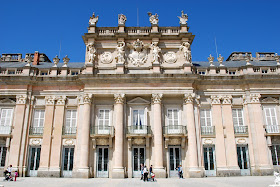 |
| Royal Palace of La Granja de San Ildefonso |
 |
| Royal Palace of La Granja de San Ildefonso |
 |
| Royal Palace of La Granja de San Ildefonso |
 |
| Royal Palace of La Granja de San Ildefonso |
 |
| Royal Palace of La Granja de San Ildefonso |
 |
| Royal Palace of La Granja de San Ildefonso |
 |
| Royal Palace of La Granja de San Ildefonso |
 |
| Royal Palace of La Granja de San Ildefonso |
 |
| Royal Palace of La Granja de San Ildefonso |
 |
| Royal Palace of La Granja de San Ildefonso |
 |
| Royal Palace of La Granja de San Ildefonso |
 |
| Royal Palace of La Granja de San Ildefonso |
 |
| Royal Palace of La Granja de San Ildefonso |
 |
| Royal Palace of La Granja de San Ildefonso |
 |
| Royal Palace of La Granja de San Ildefonso |
 |
| Royal Palace of La Granja de San Ildefonso |
 |
| Royal Palace of La Granja de San Ildefonso |
 |
| Royal Palace of La Granja de San Ildefonso |
After leaving La Granja Palace, I drove just slightly north to Segovia. I was happy to see that the city was much smaller than Toledo and Cordoba had been, so I was hopeful that the drive to my hotel would be easier than my horrid experience in Cordoba. Unfortunately, I did encounter some slight confusion as the city was undergoing a lot of construction, but I found the hotel quickly enough. I had chosen to stay at Hostal Don Jamie due to its positive reviews from Rick Steves and Trip Advisor, and also because it was located just outside of the city walls. The room was decent and because it was located on the third floor, I had a great view of the charming street in front of the hotel. Just as the reviews had indicated, it was literally just a few minutes walk from the famous aqueduct. At a cost of only 63 per night, I thought this place was a great find!
 |
| Hostal Don Jamie in Segovia. |
 |
| Hostal Don Jamie in Segovia. |
 |
| Hostal Don Jamie in Segovia. |
As I was very excited to see Segovia, I quickly left my hotel room and headed for the aqueduct. Segovia was once a military base for the Roman army and as a result, needed a lot of water to supply the inhabitants of the city. A nine-mile long aqueduct was eventually built to channel water from the Rio Frio (cold river) into the city. Of those original nine miles only 2,500 feet are currently exposed for all to see at the entrance to the city walls. I was shocked to see that the imposing walls of the aqueduct were 100 feet high! I was also amazed by the dozens and dozens of photogenic arches (166 total covering two levels). While I had seen many forms of Roman architecture in Italy, I had never before seen anything quite like this. The architecture and lines in the structure of the aqueduct provided an incredible backdrop to the streets in Segovia. It was very impressive to think of the work that went into forming the 20,000 granite blocks (without mortar, I might add) into a massive structure that contained rounded arches. Even more impressive though, is the fact that the aqueduct is 2,000 years old and is still standing in awesome condition!
 |
| Segovia's Aqueduct |
 |
| Segovia's Aqueduct |
 |
| Segovia's Aqueduct |
 |
| Segovia's Aqueduct |
 |
| Segovia's Aqueduct |
 |
| Segovia's Aqueduct |
 |
| Segovia's Aqueduct |
As I viewed the city streets from the aqueduct and began walking through Segovia, I instantly fell in love with the town. It was filled with charming architecture in excellent condition, buzzing restaurants and cafes filled with people, and an energetic vibe that was captivating. I loved the warm toned colors of the attractive buildings and the narrow winding streets; everything was so different, yet meshed together so perfectly. I was immediately thankful that I had decided to come to this special little town.
 |
| Segovia |
 |
| Segovia |
 |
| Segovia |
 |
| Segovia |
 |
| Segovia |
 |
| Segovia |
 |
| Segovia |
 |
| Segovia |
 |
| Segovia |
 |
| Segovia |
 |
| Segovia's Plaza Mayor. |
 |
| Segovia |
 |
| Segovia |
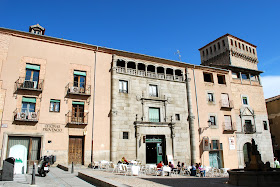 |
| Segovia |
After admiring the aqueduct, I walked through the streets, passing through Plaza Mayor before finally reaching the Cathedral, which loomed majestically over the plaza. It was built in the late Gothic style between 1522 and 1577 and was Spain's last major Gothic building. As with the cathedral in Toledo, visitors were not allowed to take photos inside but I managed to sneak a few in. While the main chapel was nothing too exciting, the cloisters were another story. I was able to walk into the small courtyard of the cloisters and get some great shots of the architecture, which made me quite happy.
 |
| Segovia's Cathedral |
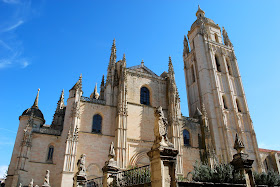 |
| Segovia's Cathedral |
 |
| Interior of Segovia's Cathedral. |
 |
| Interior of Segovia's Cathedral. |
 |
| Interior of Segovia's Cathedral. |
 |
| Interior of Segovia's Cathedral. |
 |
| Segovia's Cathedral |
 |
| Segovia's Cathedral |
 |
| The cloisters inside Segovia's Cathedral. |
 |
| Interior of Segovia's Cathedral. |
From the cathedral, I continued walking through Segovia, eventually reaching the Alcázar, which is a fortified palace. The building on the site originally began as an Arab fort but was conquered by King Alfonso VI at the end of the 11th century. The Alcázar was one of the favorite residences of the monarchs during the Middle Ages. The conical spires and the slate roof were not added until the 16th century; however, these tiles were partially destroyed by a massive fire in 1862 but later restored as can be seen today. I paid 6 Euros to enter the building which included admittance up to the tower in addition to the rooms of the palace. I decided to head up to the tower first in order to beat a massive tour group that was shortly behind me. I had to climb lots of stairs (152) to the tower, but the hard work was all worth it as the views of Segovia from the top were incredible. In addition to seeing the sun and bright blue skies, I could also see a backdrop of a nearby mountain range against the city skyline which was gorgeous. After admiring the views from the top, I headed down in order to tour the rooms within the palace. There were several fascinating rooms, including some with Moorish decor and elaborately decorated ceilings. Overall, I was much more impressed with both the interior and exterior of the Alcázar than I had originally thought I would be.
 |
| Segovia's Alcazar |
 |
| Segovia's Alcazar |
 |
| The view from Segovia's Alcazar. |
 |
| The view from Segovia's Alcazar. |
 |
| Segovia's Alcazar |
 |
| Segovia's Alcazar |
 |
| Segovia's Alcazar |
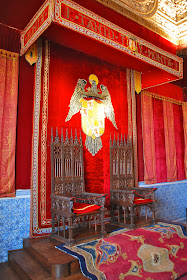 |
| Segovia's Alcazar |
 |
| Segovia's Alcazar |
 |
| Segovia's Alcazar |
 |
| Segovia's Alcazar |
 |
| View from Segovia's Alcazar |
 |
| View from Segovia's Alcazar. |
 |
| Segovia's Alcazar |
 |
| Segovia's Alcazar |
 |
| Segovia's Alcazar |
 |
| Segovia's Alcazar |
During my walk through the city, I found an awesome bakery called Limon y Menta, which was located just off of Plaza Mayor. I stopped by not just once, but twice to buy some pastries since they were so delicious!
 |
| Pastry from Limon y Menta in Segovia. |
 |
| Pastry from Limon y Menta in Segovia. |
Before heading back to the hotel room I spent some additional time photographing the aqueduct and even walking to the edge of the structure, which I found quite fascinating.
 |
| Segovia's Aqueduct |
 |
| The view from Segovia's aqueduct. |
 |
| Segovia's Aqueduct |
 |
| Segovia's Aqueduct |
 |
| Segovia's Aqueduct |
 |
| Segovia's Aqueduct |
 |
| Segovia's Aqueduct |
 |
| Segovia's Aqueduct |
 |
| Segovia's Aqueduct |
 |
| Segovia's Aqueduct |
After touring the city, I walked back to the hotel for a few hours to relax. I left again around 20:00 in hopes to eat dinner at a restaurant called Restaurante Casa Chapete, which was located across the street from my hotel. Since Segovia is famous for its roast suckling pig, I figured I had to try it! Roast suckling pig is a young pig that has only fed on its mother's milk. The poor baby is slaughtered between the ages of two to six weeks and then roasted for several hours before serving. I had read that the flesh of the baby pig is pale and tender, which causes the skin to become very crispy after it has been roasted. All of this sounded good to me, the obvious exception being that it was a baby and not a full grown pig that had been able to somewhat enjoy its life.
Along with the restaurant I mentioned above, there was also another one on the same street as my hotel that served roast suckling pig. Unfortunately, both places were closed. I had waited and waited, but by 20:45, neither had opened and obviously weren’t going to be opening. I later realized that one of the places was listed in the Rick Steves book (I had missed it) and stated it was only open for lunch; maybe the same was true for the other place, but I'll never know.
Even after the frustrations, I was still determined to try roast suckling pig. I ended up going to a touristy, but well-known place for roast suckling pig called Restaurante Duque. The price of the roast suckling pig at the restaurant was quite expensive at 20 Euros per person. I wasn’t very happy as the other restaurants near my hotel advertised prices that were less than 15 Euros. I arrived at the restaurant at 21:00 and although I was expecting to see a huge crowd of people, there was not a single soul in that place! I was quite surprised, but I guess it was an obvious sign of the lovely economy and lack of tourists.
After placing my order, I waited about 20 minutes until my roast suckling pig arrived. Even though I knew I was going to be eating a baby pig, I was absolutely horrified at the sight of the pig being wheeled out to me. With the exception of chopping off his nose, the rest of the body was left intact so there was no hiding the fact of what I was about to eat. In the back of my mind, I was hoping that the poor little soul would taste good; otherwise, this experience would have been for nothing except for another lost life. Unfortunately, the pig was just okay. Certainly not what I had expected it to taste like based on the tremendous amount of positive accolades it had received. I was not as impressed as I had hoped to be and was not exactly sure what the big deal was about the famous pork. I felt that the Hawaiian style of kalua pork was a thousand times tastier, and not to mention, much cheaper! Dinner came to 25 Euro total with tip, so about $33.75 total. In the end, my guilty conscience of eating a baby pig was intensified by the fact that the taste was not worth its life. I'll never make the same mistake again.
 |
| Restaurante Duque in Segovia. |
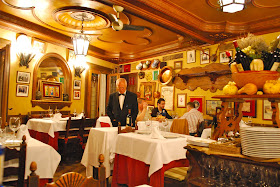 |
| Restaurante Duque in Segovia. |
 |
| Restaurante Duque in Segovia. |
After dinner, I walked through Segovia towards my hotel and attempted to buy churros at a chocolate place. Unfortunately I arrived just as it was just closing so I was unsuccessful. I didn’t seem to have good luck that day on the food front. However, food issues aside, I had had a wonderful day in charming Segovia. It's the type of city I could see myself returning to time after time again and recommend it without any hesitation to all who visit this part of Spain.

No comments:
Post a Comment